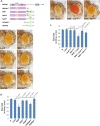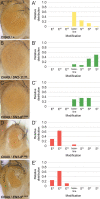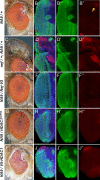A genetic screen in Drosophila uncovers the multifaceted properties of the NUP98-HOXA9 oncogene
- PMID: 34383740
- PMCID: PMC8384169
- DOI: 10.1371/journal.pgen.1009730
A genetic screen in Drosophila uncovers the multifaceted properties of the NUP98-HOXA9 oncogene
Abstract
Acute myeloid leukemia (AML) underlies the uncontrolled accumulation of immature myeloid blasts. Several cytogenetic abnormalities have been associated with AML. Among these is the NUP98-HOXA9 (NA9) translocation that fuses the Phe-Gly repeats of nucleoporin NUP98 to the homeodomain of the transcription factor HOXA9. The mechanisms enabling NA9-induced leukemia are poorly understood. Here, we conducted a genetic screen in Drosophila for modifiers of NA9. The screen uncovered 29 complementation groups, including genes with mammalian homologs known to impinge on NA9 activity. Markedly, the modifiers encompassed a diversity of functional categories, suggesting that NA9 perturbs multiple intracellular events. Unexpectedly, we discovered that NA9 promotes cell fate transdetermination and that this phenomenon is greatly influenced by NA9 modifiers involved in epigenetic regulation. Together, our work reveals a network of genes functionally connected to NA9 that not only provides insights into its mechanism of action, but also represents potential therapeutic targets.
Conflict of interest statement
The authors have declared that no competing interests exist.
Figures







References
Publication types
MeSH terms
Substances
LinkOut - more resources
Full Text Sources
Molecular Biology Databases

